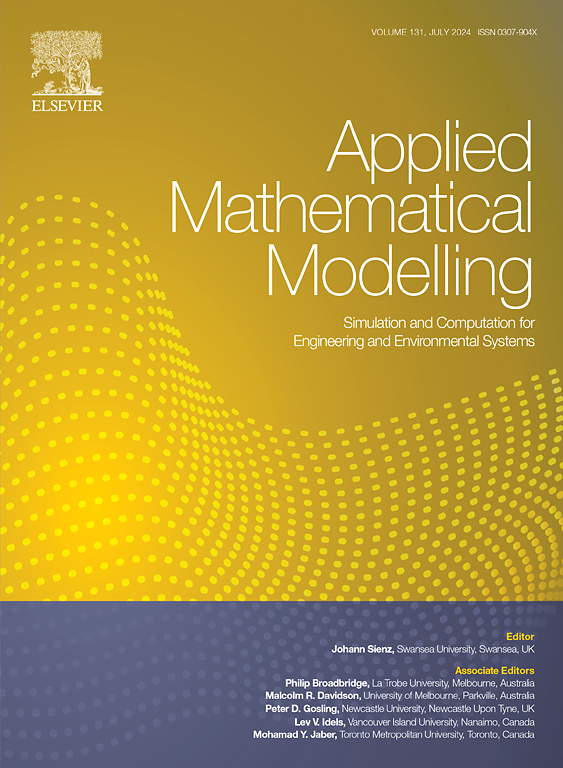具有多个零刚度点的准零刚度隔振器的质量载荷偏差
IF 4.4
2区 工程技术
Q1 ENGINEERING, MULTIDISCIPLINARY
引用次数: 0
摘要
本文提出了一种具有三个零刚度点的准零刚度隔振器,以有效地应对质量负载偏差。现有的大多数QZS隔振器都是针对单个质量设计的。结构确定后,当质量载荷发生偏差时,隔振器的隔振性能将受到显著影响。本文设计的隔离器具有多个ZS点,从而扩大了QZS区间,同时有效降低了对质量变化的灵敏度。基于拉格朗日方程建立了系统的动力学方程,并深入分析了各参数对系统刚度特性的影响。应用改进的增量谐波平衡法(IHB)分析了隔振器的动态特性,分别讨论了不同质量、不同刚度特性和固定激励下质量变化对隔振性能的影响。刚度软化区间的存在有效地抑制了刚度硬化对隔振性能的影响。QZS隔振器能有效解决系统刚度波动较小时被隔振质量出现偏差的问题。当刚度波动较大时,同一隔振器可以同时满足三种不同质量的隔振要求。本文的研究结果为克服QZS隔振器对质量变化敏感的缺点,实现对多质量的有效隔振提供了研究思路。本文章由计算机程序翻译,如有差异,请以英文原文为准。
On a quasi-zero stiffness vibration isolator with multiple zero stiffness points for mass load deviation
This paper proposes a quasi-zero stiffness (QZS) isolator with three zero stiffness (ZS) points to cope effectively with mass load deviations. Most of the existing QZS vibration isolators are designed for a single mass. The vibration isolation performance of the isolator is significantly affected when the mass load deviates after the structure has been determined. The isolators designed in this paper have multiple ZS points, thereby enlarging the QZS interval while effectively reducing the sensitivity to mass changes. The dynamic equations of the system are constructed based on the Lagrange equation, and the influence of the parameters on the stiffness characteristics is analyzed thoroughly. The modified incremental harmonic balance method (IHB) is applied to analyze the dynamic characteristics of the vibration isolator, and the effects of different masses, different stiffness characteristics, and mass variation under fixed excitation on the vibration isolation performance are discussed separately. The presence of stiffness-softening intervals effectively suppresses the impact of stiffness-hardening on vibration isolation performance. The QZS isolator can effectively solve the problem of deviation of the isolated mass when the system stiffness fluctuation is small. The same isolator can simultaneously satisfy the vibration isolation requirements of three different masses when stiffness fluctuations are large. The results of this paper provide a research idea for overcoming the shortcomings of QZS vibration isolators, which are sensitive to mass changes, and for realizing effective vibration isolation for multiple masses.
求助全文
通过发布文献求助,成功后即可免费获取论文全文。
去求助
来源期刊

Applied Mathematical Modelling
数学-工程:综合
CiteScore
9.80
自引率
8.00%
发文量
508
审稿时长
43 days
期刊介绍:
Applied Mathematical Modelling focuses on research related to the mathematical modelling of engineering and environmental processes, manufacturing, and industrial systems. A significant emerging area of research activity involves multiphysics processes, and contributions in this area are particularly encouraged.
This influential publication covers a wide spectrum of subjects including heat transfer, fluid mechanics, CFD, and transport phenomena; solid mechanics and mechanics of metals; electromagnets and MHD; reliability modelling and system optimization; finite volume, finite element, and boundary element procedures; modelling of inventory, industrial, manufacturing and logistics systems for viable decision making; civil engineering systems and structures; mineral and energy resources; relevant software engineering issues associated with CAD and CAE; and materials and metallurgical engineering.
Applied Mathematical Modelling is primarily interested in papers developing increased insights into real-world problems through novel mathematical modelling, novel applications or a combination of these. Papers employing existing numerical techniques must demonstrate sufficient novelty in the solution of practical problems. Papers on fuzzy logic in decision-making or purely financial mathematics are normally not considered. Research on fractional differential equations, bifurcation, and numerical methods needs to include practical examples. Population dynamics must solve realistic scenarios. Papers in the area of logistics and business modelling should demonstrate meaningful managerial insight. Submissions with no real-world application will not be considered.
 求助内容:
求助内容: 应助结果提醒方式:
应助结果提醒方式:


